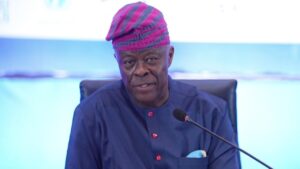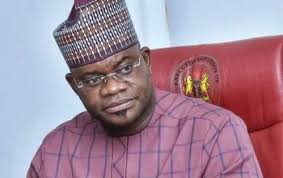FG spends N604.19bn on domestic debt service
By Kayode Tokede
A report by the National Bureau of Statistics (NBS) has disclosed that Federal government spent N604.19billion to service domestic debt between July and September (Q3) of 2020.
The breakdown revealed that the federal government actual domestic debt service for Q3 2020 on NTBs was N97.64billion as against N43.63billion reported in Q3 2019, while interest on debt service of FBN bond was N488.5billion between July to September of 2020.
In addition, N9.38billion was interest on Treasury bond debt service, N365.65million on FGN saving bond and N8.28billion on FBN Sukuk as of Q3 2020.
The NBS disclosed that Nigerian States and federal government total public debt portfolio stood at N32.22trillion or $84.6billion as of third quarter ended September 30, 2020.
The “Nigerian domestic and foreign debt” report released by NBS on Wednesday stated, Nigeria’s total public debt showed that N12.19trillion or 37.82per cent of the debt was external while N20.04trillion or 62.18per cent of the debt was domestic.
The report stated that “Further disaggregation of Nigeria’s foreign debt showed that $16.74billion of the debt was multilateral; $502.38million was bilateral (AFD) and another $3.26billion bilateral from the Exim Bank of China, JICA, India, and KFW while $11.17billion was commercial which are Eurobonds and Diaspora Bonds.”
The report stated that FGN total external debt as of Q3 2020 was N12.19 trillion or $31.99billion while FGN and states & FCT total domestic debt was N20.04trillion or $52.6billion as of Q3 2020.
From the NBS report, the FGN total external debt was N8.27trillion or $26.94billion as of Q3 2019, while FGN, States and FCT domestic debt was N17.94trillion or $58.45billion as of Q3 2019.
This brings total public debt by FGN and states to N26.21trillion or $85.39billion as of Q3 2019.
The NBS domestic debt stock by instrument as at September 30, 2020 revealed that 73.53 per cent or N11.65trillion was borrowed through FBN bonds; 17.17 per cent or N2.72trillion through the Nigerian Treasury Bills (NTBs) and 2.29 per cent or N362.56billion through FGN Sukuk.
Others are 6.13 per cent or N971.88billion through promissory notes, 0.64 per cent or N100.99billion through Nigerian treasury bonds, 0.16 per cent or N25.69billion through green bond; and 0.08 per cent through N12.56 billion through FGN Saving bond.
The report stated that a total of N15.85trillion was the domestic debt stock by instrument as at Q3 2020 as against N13.9 trillion reported in Q3 2019.
Nigeria’s debt profile continued to snowball and its attendant cost is worrisome as members of the CBN’s Monetary Policy Committee (MPC) noted the rising burden of debt services.
They had urged the federal authority to strengthen its debt management strategy, explore other sources of revenue, as well as enhance efficiency in public expenditure.
A member of the MPC, a professor at the University of Ibadan, Festus Adenikinju in his personal statement, said “The fiscal system continues to pose significant challenges arising from current underperformance of government revenue, unrestraint growth in government recurrent expenditure, underperformance of capital expenditure and rising debt service ratio.
“Debt service rate rose to 84.1 per cent of government revenue between January and August 2020 compared to 51.5 per cent in January to August of 2019.”
The country pays a lump sum to several external organizations that grant loans to it, and these include the World Bank, African Development Bank (AfDB), Exim Bank of China, Exim Bank of India and so on.
In 2015, which marked the start of President Muhammadu Buhari’s first term administration in office, Nigeria paid $16.34 billion to service debt payment.
Fast forward to 2018, the sum of $13.74 billion was recorded while $21.22billion was paid in 2019.
The budget office of the federation in a report stated that “Total debt service in the half year of 2020 stood at N1.1trllion indicating a decrease of N234.04 billion (17.47 percent) from the N1.34trillion projected for the half year period.
“The sum of N853.61 billion was used for domestic debt servicing while N251.76 billion was spent for external debt servicing during the period under review. The amount used for domestic debt servicing revealed a difference of N83.06 billion (8.87 percent) from its half year projection.”
Experts continue to stress that while the country’s debt to GDP ratio is sustainable for now, the cost of servicing the debt eats deep into the country’s already depleting revenue.
Critics of the government have complained about the government’s penchant for debts, believing that it could put the future of younger Nigerians in jeopardy.
The Deputy Governor, Financial System Stability, CBN, Mrs. Aisha Ahmad, started that, “low oil prices, muted fiscal revenues and significant debt service obligations have dramatically restricted the already fragile fiscal space.
“Further fiscal adjustments will be required to curtail rising public debt and budget deficit, in addition to prioritization of government spending to support the Economic Sustainability Plan (ESP).”
AfDB early in the year said debt servicing gulps more than 50 per cent of Nigeria’s revenue.
The bank, which said this in its West Africa Economic Outlook last year, said the servicing of the country’s external debt gulped about 50 per cent of the country’s revenue.
According to AfDB, the average revenue spent by West African countries on external debt servicing is 17 per cent. This is high and even higher in Nigeria which spends about 50 per cent revenue on external debt servicing. It added that with the increasing domestic debt burden, the percentage of revenues spent on debt servicing in Nigeria was even higher.
The bank said that even though the country’s debt burden had increased by as much as 128 per cent in the last eight years, Nigeria’s debt to Gross Domestic Product remained low.
The low debt-to-GDP ratio notwithstanding, it added, the problem with the nation’s increasing debt burden was the high proportion of revenue spent on debt servicing.
It said, “Cape Verde had the highest external debt-to-GDP ratio in 2018, an estimated 103 per cent, followed by Senegal, Niger, and Sierra Leone. Liberia had the highest rate of debt accumulation between 2010 and 2018, at 329 per cent, followed by Nigeria at 128 per cent.
“Despite the increase, Nigeria still has one of the lowest external debt-to-GDP ratios, at 15.2 per cent. Benin, Guinea-Bissau and Togo also have a ratio below 25 per cent.
“The rapid increase in external indebtedness remains a challenge, especially given the shift toward non-concessional external debt. Debt service payments have also increased since 2010 and are projected to remain high in the medium term.”
The bank added, “The increase has heightened the fiscal burden in an already fiscally and growth-constrained environment. This raises important concerns regarding the sustainability of external debt. West African countries spend an average of 17 per cent of revenue on servicing external debt.
“In Nigeria, about half of the revenue is used to service external debt. The increasing domestic debt burden means that the total proportion of the revenue spent on servicing debt is even higher. In a country where only six per cent of GDP is collected in revenue, the high burden of debt service is a major concern.”




